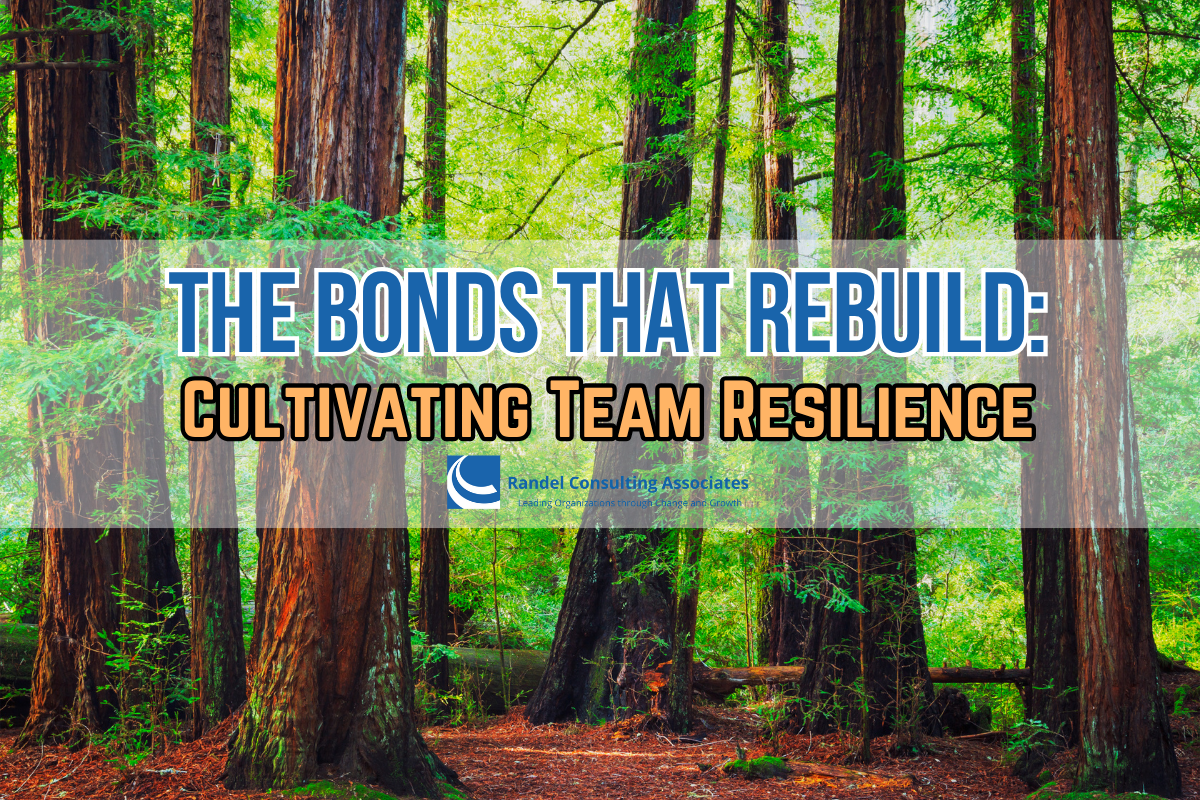Dear Change Leader,
When a storm strikes, it’s not the strongest tree that necessarily survives—it’s the grove with intertwined root systems supporting each other through the gale.
As we continue exploring resilience, let’s focus on what might be the most powerful dimension: relational resilience—the unique strength that emerges when teams bond through disruption.
The Hidden Power of Collective Recovery
Relational resilience is a team’s capacity to absorb shock, regroup after disruption, and recommit to their shared purpose. Unlike personal resilience (internal resources) or organizational resilience (systems and structures), relational resilience lives in the connections between people.
A Lesson in Team Resilience
Some years ago, I worked with a team preparing to launch a transformational project for their country. Despite careful risk planning, we couldn’t anticipate what was coming.
Weeks after our workshop, a disputed presidential election plunged the country into conflict, bringing operations to a standstill. Several uncertain months passed before stability gradually returned.
When the team was finally able to reconvene, they faced a fundamentally altered landscape. Their response revealed the essence of relational resilience—they began not by rushing back to the project plan, but by reconnecting as humans.
Team members created space to share their personal experiences during the disruption. Each person’s story was heard with attention and care. This wasn’t merely a ceremonial check-in—it was rebuilding the relational foundation necessary for their work.
Only after reestablishing these connections did they reassess their project assumptions and modify their approach. Over the next five years, this resilient team successfully implemented their revised project, ultimately providing millions of people with improved services.
Their success wasn’t despite the disruption—in many ways, it stemmed from how they responded to it together.
Four Practices for Building Team Resilience
What makes some teams crumble under pressure while others emerge stronger? Four interconnected practices distinguish resilient teams:
1. Cultivate Authentic Connection
- Create space for genuine human interaction beyond professional roles
- Practice vulnerable communication where challenges can be openly shared
- Maintain connection during disruption, not just when things are going well
Practical Action: Begin team meetings with a meaningful check-in: “What from your personal life and experience is present with you at this time?”
2. Maintain a Living Purpose
- Regularly refresh your shared understanding of purpose
- Stay flexible about methods while remaining committed to meaning
- Use purpose as a decision filter when priorities must shift
Practical Action: After any significant disruption, reconnect explicitly with your team’s purpose: “Given current realities, how might our work matter even more?”
3. Practice Collaborative Sense-making
- Gather diverse perspectives on what’s happening and what it means
- Challenge assumptions openly without attacking the people holding them
- Develop shared language for the changes you’re experiencing
Practical Action: Use “What? So What? Now What?” questions to guide discussions after disruption.
4. Embody Mutual Care
- Normalize talking about capacity, energy, and needs
- Create backup systems so individuals can step back when necessary
- Actively protect against burnout by monitoring the collective workload
Practical Action: Institute a regular “capacity check” where team members can discuss their current bandwidth and request support.
Your Team Resilience Conversation
This week, I invite you to initiate a 30-minute discussion with your team:
- “When we’ve faced disruptions in the past, what helped us recover together?”
- “What practices could strengthen our ability to navigate future challenges?”
- “How might we better support each other when things get difficult?”
The simple act of naming resilience as a team priority can itself strengthen your collective capacity to weather whatever storms may come.
Remember, in uncertain times, the quality of your team’s connections may be your most valuable resource.
Until next time,
Develop Your Pathfinder Leadership Skills
Are you ready to strengthen your ability to navigate uncertain terrain with confidence?
I’m excited to announce an upcoming program specifically designed for change leaders facing today’s unprecedented challenges. The Pathfinder’s Journey: Leading Through Uncertainty will provide you with practical frameworks, peer support, and expert guidance to help you:
- Develop a keen sense for assessing changing organizational terrain
- Build adaptive decision-making skills for rapidly shifting environments
- Create teams that can respond with agility to unexpected challenges
- Maintain your leadership presence and well-being during prolonged uncertainty
Program details are being finalized, but spaces will be limited.
If you’re curious about this opportunity, please click the button below to join the interest list. There’s no obligation, but if you’d like to be among the first to receive information when applications open, click the button below.
Those on the interest list will also receive a complimentary copy of my article “Leading Like A Gardener” – a practical resource to support your leadership journey.
I look forward to sharing more details soon!
EFFECTIVE CHANGE RESULTS FROM INTENTIONAL LEADERSHIP
We’re a leadership and organization development consultancy. My team and I work with leaders like you to prepare for and lead successful change processes.
Here’s why our clients call us:
- Leadership Coaching: I support leaders as they navigate transitions into new roles or expanded responsibilities.
- Group Coaching and Learning Programs: Bringing groups of leaders together, I facilitate learning experiences and months-long programs that equip people to be effective change leaders.
- Effective Teams and Stronger Organizations: I work with leaders and their teams with tailored processes that increase their effectiveness, building layers of aligned teams that transform organizations.


